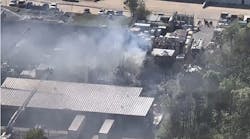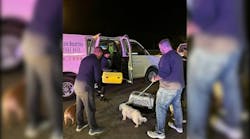"Abbottville" is a 12-by-18-foot diorama created by Command Emergency Response Training (CERT) that can be set up to resemble any city, town or rural area.
What makes "Abbottville" different from other tabletops is that we use actual case studies of incidents. We have more than 80 scenarios - everything from fires and hazmat spills to plane and train crashes.
We develop each script from case studies, using whatever materials and sources are available, including shipping documents, Manufacturer Safety Data Sheets (MSDS), building diagrams and interviews with participants in emergency incidents. We have, at times, built models of the buildings involved in the case studies. By using real incidents and case studies we provide a benchmark that can be used to examine how the student participants handle the tabletop incident compared to the actual events outlined in the case study.
CERT's intent is to provide a positive atmosphere for learning. We do not attempt to mislead, embarrass or point fingers at the participants. We use a traffic light as a teaching aid. This light is green at the beginning of each exercise, signifying that the situation is going well, and can change colors as the result of student actions. A yellow light indicates that a situation or action has occurred that could cause emergency responders to be injured or killed. When the problem is corrected, the light goes back to green. If the action is not corrected, the light turns red and all action is stopped. A time-out is taken to discuss the actions or inactions of the students and what can be done to correct the problem. The incident is then re-started after the action/inaction is corrected.
We use HO-scale vehicles of the likeness used by police, fire, EMS, public works and other agencies. Colored string is used to simulate fire hose sizes; lays are made from hydrants that are on the tabletop. In some cases, there are no hydrants in the area, so tankers and small dump tanks are available for use by the students for drafting operations. We also provide manning - small HO-scaled "people" representing firefighters with and without SCBA, police, EMTs and paramedics, and others in the responding community, including hazmat levels A and B.
The realism provided by "Abbottville" establishes the mindset of the students to perform as they would in an actual emergency. Actual fire and smoke are used to add to the realism. The fire is not allowed to be extinguished until the correct gpm has been established and lines and attack positions provide for extinguishment. Real chemicals that were spilled or leaked during an incident may be used in small amounts to let the students use monitoring equipment we provide to determine protection, hazard zones and whether to evacuate or protect in-place. We even use emergency-incident sound effects.
We've found that role playing greatly enhances the realism of the scenarios. Bev often plays the role of the 911 dispatcher and Don may play a train engineer, company owner or a reporter.
We started out training mainly fire departments in the incident command system (ICS), tactics and safety procedures but we soon incorporated all aspects of emergency management and unified command into the scenarios. "Abbottville" lends itself to emergency management agencies and local emergency planning committees. We also assist police and EMS agencies with their training. When petro-chemical and refinery facilities learned of "Abbottville," they requested help in training in-plant emergency responders. They also invited local emergency agencies to practice unified command. Don has even been contracted to build several "on site" setups that resemble company property.
The props that we use are very important to our goal of realism. Don believes that the more detail he uses on "Abbottville," the more the participants will get out of the training. People who have trained on "Abbottville" can tell you about the train that cuts any five-inch hose that was placed across rail tracks or the screaming wife of a man inside a burning building.
The larger the incident becomes, the more people we get directly involved. It is amazing to see the transformation of someone given a hat that says "mayor" or a vest that says"incident commander." They, and all the other participants, become so involved in the incidents that beads of sweat have been raised on some of the most experienced emergency responders.
We use our research of the incidents during the critique that we have after each scenario. Each participant is given the opportunity to talk about how the incident was handled, and to ask questions. Don then relates how the real incident was handled, so the participants can compare their actions to the actual response.
We stay up-to-date by visiting the National Fire Academy in Emmitsburg, MD, as often as we can to review the many case histories on file. Examples of our scenarios are:
- Chemical fire. A commercial building is fully involved, with fire burning through the roof. Will the students recognize the building has a bowstring construction? Will they obtain MSDS and recognize the material burning would be best left to burn? Can Don, as the business owner, talk them into going into the building to search for missing employees?
- Train vs. school bus. A train strikes a school bus carrying more than 30 children. Will the students learn how to turn off the loud and annoying bell? Will they obtain the correct number of students on the bus from the school? Will they set up proper EMS and rescue operations? Will they recognize the instability of the bus and the live power line laying across the bus? Will they prepare for the onslaught of parents and news media? Is good unified command established?
There are many means of handling emergencies but one thing is clear - everyone's goal is to help others and be as safe as possible while doing so. Every time we leave a community or organization, we feel good that we have had a small part in helping it accomplish its goals.
Don and Bev Abbott own Command Emergency Response Training (CERT) and created the "Abbottville" tabletop simulator training program. Don retired in 1995 as a division chief of the Warren Township Fire Department in Indianapolis, where he was chief of Special Operations and Support Services. He also was coordinator of the Marion County, IN, Hazardous Materials Task Force. Don has an associate's degree in fire science technology and hazmat management and is completing a bachelor's degree in public safety administration. Bev retired in 1995 from the Warren Township Trustee Government Office. She received her firefighter first class certification and training and dispatch/communications experience through the Warren Township Fire Department. Bev is the official "dispatcher/911 operator" for the "Abbottville Fire Department."








